You’re working on your car and blasting away with the pneumatic impact tool. You take a break about halfway through because you’re due for one, and that’s when you see it. The inscription on the handle of the impact says, “Oil daily.” That’s right about when your stomach drops. You haven’t oiled it once in your life.
Rather than taking the chance of having that thing come apart in your hands, you switch back to the breaker bar and elbow grease until you can buy a new one. Did you have to, though? You might not know that oil is also necessary to prevent moisture that naturally builds up due to compressed air. As air runs through the system, the pressure and the moisture will work to remove any lubrication, and that’s why frequent oiling is recommended.
Photo by Hank O’HopThe good news is that oiling your pneumatics is a lot simpler than you might think. In fact, it’s only going to take a few seconds. Car Bibles got its tool wizards on the case, and we’re going to walk you through the process to make sure you never run those bad boys dry again.
Oiling your pneumatic tools is pretty straightforward, and there aren’t many ways to harm yourself. Still, you are dealing with tools and oils that you might not want to get on your bare skin. So, a set of protective gloves and safety glasses are a good idea.
Any time we discuss pneumatics, it’s also a good idea to talk about some general safety tips. For one, always wear hearing protection when operating these tools. You’ve only got one set of ears, and these tools are loud. Do your future self a favor and throw some earplugs in any time you put air pressure to work.
Always be mindful of the condition of the system. It’s not worth the risk of running compressed air through swollen lines, busted tools, or a run-down compressor. Pneumatic systems are safe when they’re in sound condition, but any compromise to their integrity can be catastrophic. That’s why you should regularly clean, inspect, and maintain everything throughout the system.
That’s why you should regularly clean, inspect, and maintain everything throughout the system.
Are you ready for this? If you’re a home mechanic who only puts your tools to use on the weekends, all you’ll need is a little bit of air-tool oil. That’s it. If you’re feeling up for it, grab a second bottle to keep on hand.
If you use pneumatic tools daily, you should apply oil at least once a day. You also might consider adding an in-line oiler to ensure there’s no risk of you forgetting to add oil and damaging the tools.
You can run cleaner through the tool if it’s due. Just try to practice a little more control than me. Photo by Hank O’HopLet’s get after it.
As we said, it’s worth making sure the tool is safe for use. It’s a good idea to give it a visual inspection before each use and make sure everything is in working order. You don’t need to tear into it every time, but ensuring there are no signs of excessive wear or binding anywhere is a good idea.
Turn the tool upside down. With the air line disconnected, squeeze a couple of drops directly into the air fitting. That’s all it takes to ensure that wherever the air flows, oil flows with it. About five or six drops is all it’ll take to lubricate the moving parts and add a layer of protection from moisture.
Squeeze the trigger or activation lever a few times before turning the tool right side up. That will open the passage that allows compressed air to run the tool, which is the same path the oil follows. If you skip this step, the oil will simply leak out when you turn the tool right side up.
If you use the tools every day, consider adding an in-line oiler to your system. This fits directly onto the air hose before the coupler the tools attach to. It will continuously feed oil through tools so you can skip out on doing it yourself.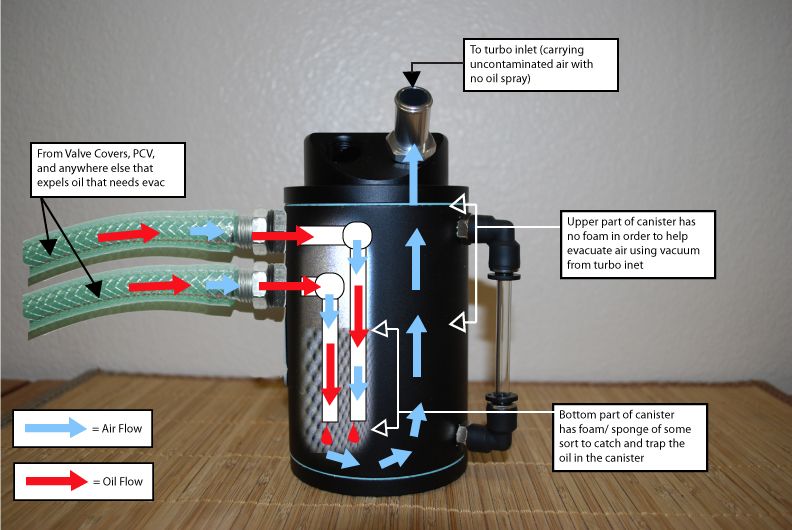 Once installed, all you have to do is top it off with oil and get to work. Remember to keep an eye on oil levels and replenish the system when necessary.
Once installed, all you have to do is top it off with oil and get to work. Remember to keep an eye on oil levels and replenish the system when necessary.
Car Bibles answers all your burning questions!
A: WD-40 is a magical formula that you will put to use in all kinds of places, but it’s not good for use in air tools. It’ll do an OK job at lubricating the parts, but it will struggle to protect from corrosion. You can use alternatives to air-tool oil in a bind, but WD-40 isn’t one of them.
A: If you don’t have air-tool oil on hand, you can use hydraulic lubricant in its place as long as it has a relatively low viscosity. An alternative you’re more likely to have on hand is automatic transmission fluid (ATF). It has lubricating properties that air tools need and will even help to protect the seals inside the tool.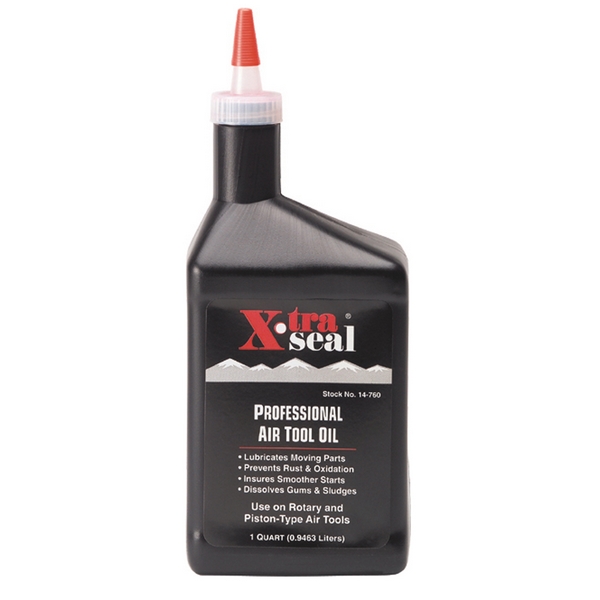 That isn’t to say you should always use these lubricants in place of proper air-tool oil. There is a reason oil specifically for the tools exists, and you’ll want to use it as often as possible.
That isn’t to say you should always use these lubricants in place of proper air-tool oil. There is a reason oil specifically for the tools exists, and you’ll want to use it as often as possible.
A: Air tools typically call to be oiled daily. If you don’t use them daily, you don’t need to worry about it. Just make sure to apply oil before and after each use. If you do, follow this guideline. But if you use the tools all day long, you’ll want to add oil more frequently. It’s wise to add a few drops every few hours. That said, adding an in-line oiler goes a long way for folks who use pneumatic tools all day, every day.
A: You can over-oil an air tool, and it’ll do more than just make a mess of things when the tool starts dripping or slinging oil around. It can hinder tool performance, ruin paint jobs, and possibly even damage the moving parts inside. That’s why you only want to apply a few drops of oil.
A: Cleaning air tools can be done in one of two ways. Dedicated solvents for cleaning air tools exist, and you spray them directly into the air fitting. Like air-tool oil, the solvent will follow all the air passages, allowing it to clean things along the way. The other method is to take the tool apart and clean everything by hand. That’s something you should also be doing every so often.
That’s really all there is to oiling your air tools. As simple as it is, we understand that some folks are visual learners. That’s why we’ve attached this short clip that shows you exactly how to apply oil to your pneumatics.
You don’t need much to get the job done.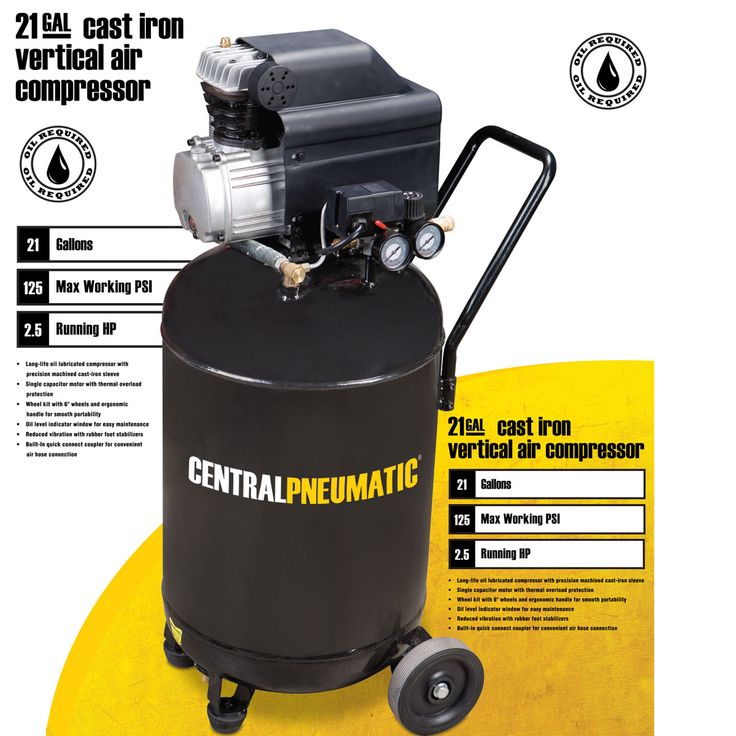 Even so, we don’t want to leave you on your own to try and figure out what’s worth your money and what isn’t. As for oiling and cleaning your air tools, we strongly recommend putting the Inline Hose Connected Air Tool Oiler Lubricator in Line Oil Oiling Attachment, Lucas Oil 10216 Air Tool Oil – 16oz., and B’laster 16-ATC Professional Air Tool Conditioner to use. We also suggest checking out the Steck Manufacturing 16600 Air Tool Oiler, Oatey 1/2 in. x 260 in. PTFE Thread Seal Tape Value-Pack, and WYNNsky High Flow V-Style Air Fittings when the time comes to update your pneumatic arsenal. You guessed it: You can snag all of these on Amazon and at Walmart.
Even so, we don’t want to leave you on your own to try and figure out what’s worth your money and what isn’t. As for oiling and cleaning your air tools, we strongly recommend putting the Inline Hose Connected Air Tool Oiler Lubricator in Line Oil Oiling Attachment, Lucas Oil 10216 Air Tool Oil – 16oz., and B’laster 16-ATC Professional Air Tool Conditioner to use. We also suggest checking out the Steck Manufacturing 16600 Air Tool Oiler, Oatey 1/2 in. x 260 in. PTFE Thread Seal Tape Value-Pack, and WYNNsky High Flow V-Style Air Fittings when the time comes to update your pneumatic arsenal. You guessed it: You can snag all of these on Amazon and at Walmart.
Disclosure: Carbibles.com is also a participant in the Amazon Services LLC Associate Programs, an affiliate advertising program designed to provide a means for sites to earn advertising fees by advertising and linking to Amazon.com. Pages on this site may include affiliate links to Amazon and its affiliate sites on which the owner of this website will make a referral commission.
Most pneumatic tools require air tool oil for optimal functionality. This oil is often expensive and sometimes hard to come by, hence the need for viable alternatives.
This article unpacks potential alternatives and how to use them.
Pneumatic oil is essential for all forms of pneumatic equipment since it provides lubrication while the equipment is in use. Here, the oil ensures less friction between moving components, prevents moisture and rust build-up, dissolves sludge, and protects O-rings.
The moving parts in air tools don’t touch. Instead, got a thin film of oil between them and they have various seals and O-rings to ensure airtight sealing. Compressed air moves the parts back and forth. To ensure proper operation, these parts require lubrication, ensuring that the seals and O-rings move as they should without getting damaged.
Following are some of the effective air tool oil substitutes. Check the tool manual before using any of these alternatives to ensure that the specific oil is safe for your application.
Check the tool manual before using any of these alternatives to ensure that the specific oil is safe for your application.
The transmission fluid works well for air tools, acting as a lubricant and generally allowing it to work as it should. ATF reduces wear and tear in air tools without creating residue on surfaces.
Automatic Transmission Fluid contains several useful additives including anti-oxidation additives, detergents, anti-foam compounds, etc. ATFs are inexpensive and are perhaps the best air oil substitute.
I suggest the Dexron Automatic Transmission Fluid as a cheaper alternative to air tool oils. Before using this oil, check for compatibility with your air tool.
Marvel Mystery Oil is suitable for most applications and can be used with most pneumatic tools. It contains a strong solvent, which will help lubricate nearly any tool under most conditions, dissolving any gummy residue inside the tool.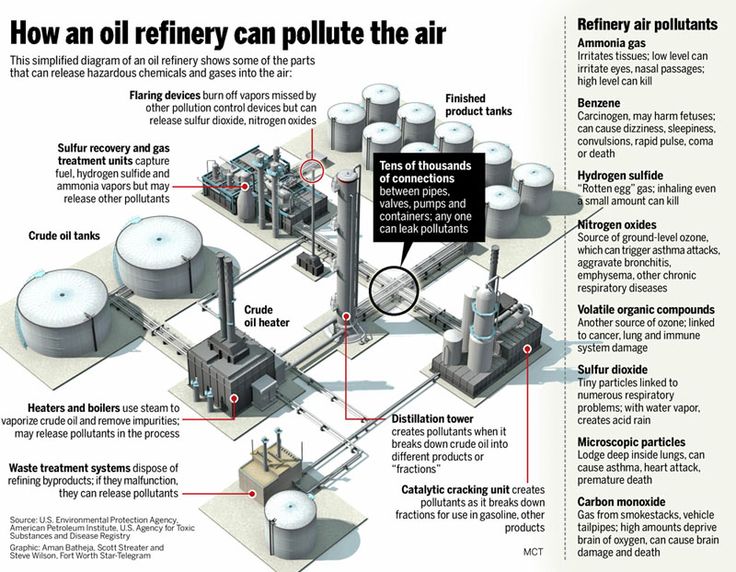
Marvel Mystery Oil – Get Here
It’s slightly more expensive than other all-purpose air tool oils but works really well and lasts long.
Hydraulic oils are ideal for high-pressure hydraulic applications, but they can also be used to lubricate lightly loaded compressors.
However, hydraulic oils usually have high viscosity and you cannot use oil with high weight on pneumatic tools.
Go with the ISO 32 hydraulic oil. This oil has a low viscosity at low temperatures, making it compatible with most pneumatic applications.
3-in-1 Oil is a petroleum-based oil that’s been in use for generations.
Generally, petroleum-based lubricants are not ideal for power tools as they can cause damage to elastomeric rubber sealings. The 3-in-1 oil seems to be the exception to the rule when it comes to petroleum-based oils and air tools. This oil is thin enough to work well in pneumatic power tools and doesn’t leave a gummy residue.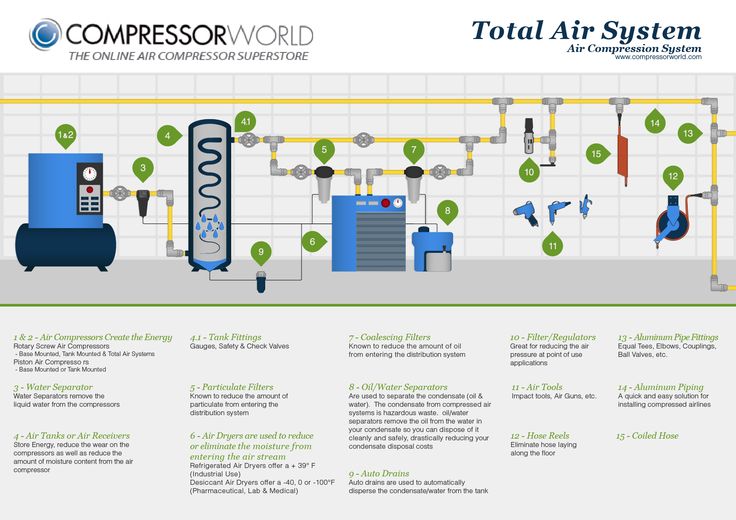
It’s perfect for most household applications with moving parts, like hinges, tools, nuts and bolts, and sewing machines.
Get 3in1 Oil for Pneumatic Tools
The 3-in-one air tool oil also dissolves sludge and gummy residue in your tool, operating it more smoothly. Make sure that you get the pneumatic tool oil and NOT the multipurpose penetrating oil.
As a last resort, you could use 10W 30 low-weight synthetic motor oil. Make sure that it is non-detergent and paraffin-free to avoid the build-up of wax inside your tool.
The above listed are some of the common alternatives to pneumatic tool oils available, and these work well in most applications. Power tool equipment manuals should always indicate which pneumatic tool oil to use with the equipment, how much of it, and oil top-up frequency. When in doubt, always refer back to the manual.
Air tool oil tends to be thinner than compressor oil.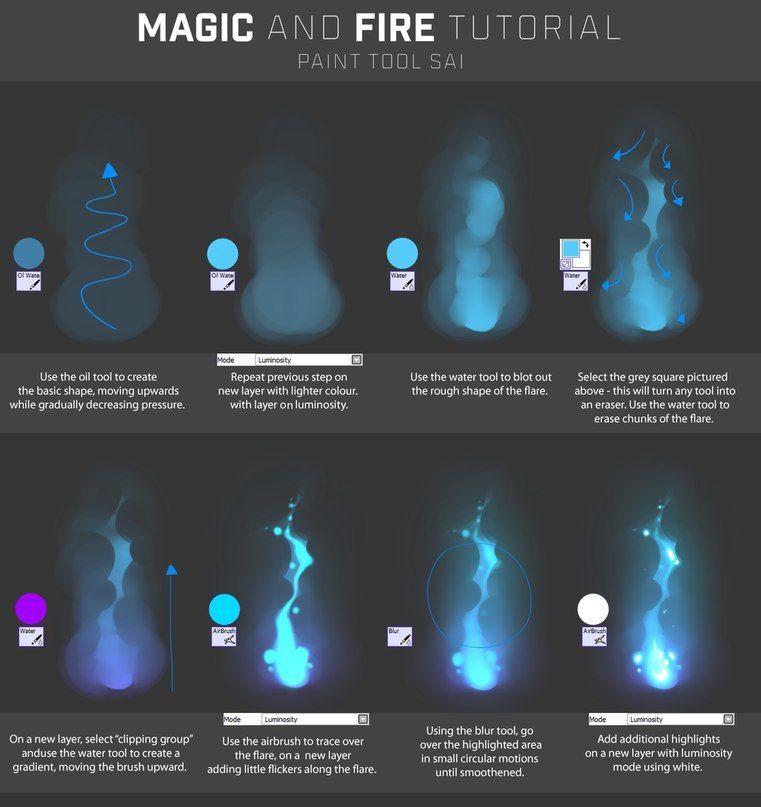 It also contains anti-rust agents. You can use a low viscous compressor oil to lubricate your air tools, but not the other way around.
It also contains anti-rust agents. You can use a low viscous compressor oil to lubricate your air tools, but not the other way around.
This is a common lubricant found in many households since a sewing machine needs to be oiled on a regular basis. So, can sewing machine oil be used for pneumatic tools?
If you have no other alternative, you could use sewing machine oil as air tool oil, although it is not recommended.
Unlike air tool oils that are mineral oils or synthetic, the sewing machine oil is a petroleum-based lubricant. Sewing machine oil may react with the rubber sealing and has a higher viscosity.
Your power tool only requires a couple of drops of oil, and one-time use of sewing machine oil is unlikely to cause any damage. However, continuous use of this lubricant can disintegrate the O-rings and will result in air leakage or jammed pistons.
Lubricating oil alternatives are legion, but some options are detrimental to your pneumatic tool’s operation.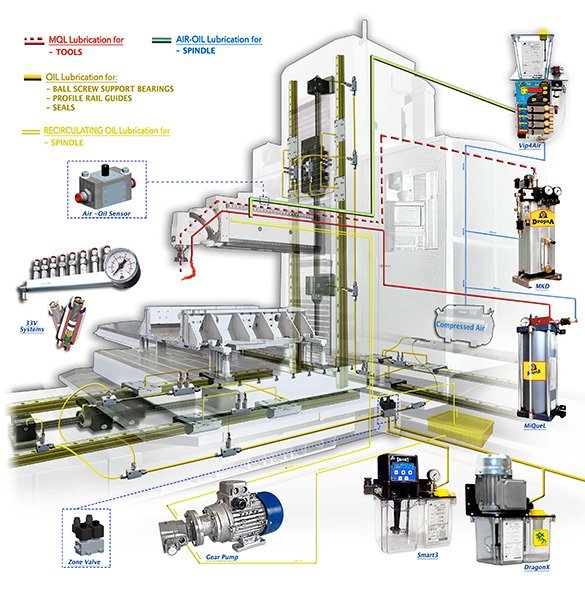 Here are the two most common ones to avoid:
Here are the two most common ones to avoid:
Diesel is petroleum-based and combustible. It’s never a good idea to use flammable, petroleum-based oils as lubricants in power tools. The petroleum reacts with the rubber made to manufacture the O-rings and other sealers inside the pneumatic tool, disintegrating them. This will create a gummy residue inside the tool, potentially damaging the tool.
In air tools such as impact wrenches or impact drivers with a built-in hammering mechanism, it can ignite diesel causing damage to the vane motor and anvil of the tool.
No, WD40 oil isn’t designed for pneumatic tools and, as such, could potentially damage your air tools. It is a degreaser that is used for removing rust, cleaning, etc. WD40 is a penetrating oil that swells the rubber sealants and in the long run dries the moving parts and can result in wear and tear.
Hence it is not recommended.
Vegetable oil produces a sticky residue inside air tools, affecting their performance and causing damage. This residue attracts dust, creating a solid deposit inside your tool or machine.
This residue attracts dust, creating a solid deposit inside your tool or machine.
Oiling air tools is a crucial step in tool maintenance. Choosing the correct oil and applying it according to the manufacturer’s guidelines ensures that your power tools function optimally and have a long lifespan.
Typically, two types of oils are available for air tools: mineral-based oil and synthetic oil.
Mineral-based pneumatic tool oils are the most commonly used and are considered the standard by most. However, this version is far more volatile than its synthetic counterpart. It thus leads to more significant oil loss during tool operation.
Mineral oil is generally more reactive than synthetic oil, and these reactions cause it to clump up. The tool life span shortens when this occurs, which counts against using mineral oil.
Synthetic tool oils are generally more expensive than their mineral-based counterparts.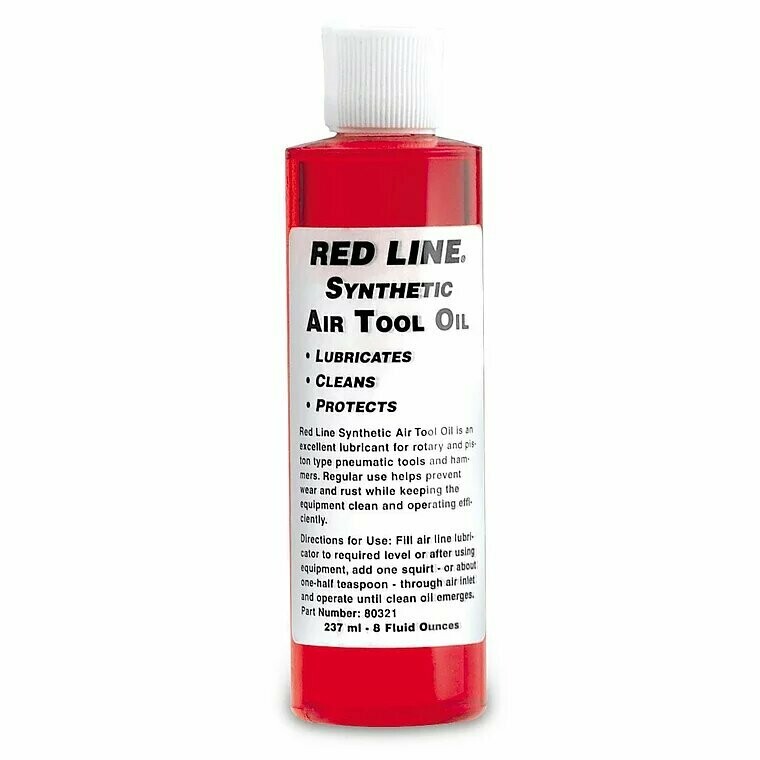 This increased expense is often worth it since it is designed as a high-performance oil. They reduce friction inside the tool, prolonging its lifespan.
This increased expense is often worth it since it is designed as a high-performance oil. They reduce friction inside the tool, prolonging its lifespan.
Synthetic oils aren’t reactive like their mineral-based counterparts and thus won’t clump up inside the tools.
Air tool oils act as a lubricant for pneumatic tools and thus have a low viscosity. They also act as anti-rust agents and clean the tools while in use. Air tool oils contain solvents that dissolve gum and sludge build-up within the tools. This type of build-up could potentially reduce the tool’s speed and power.
In short, the oil should have the following properties.
Air tool oils’ low viscosity allows them to be easily atomized, spreading throughout the tool by compressed air. SAE (Society of Automotive Engineers) specifications govern the weight and viscosity. Typical applications call for ISO 32 grade or SAE 10 oil.
SAE (Society of Automotive Engineers) specifications govern the weight and viscosity. Typical applications call for ISO 32 grade or SAE 10 oil.
Here, the 10 represents an oil thickness rating under operating conditions, specifically how temperature affects it.
Oils with a viscosity between ISO 22 to 46 can be used for pneumatic tools, depending on the application.
Oiling air tools is an essential step in basic maintenance. It should be done as frequently as is indicated in the user manual. This differs between tools and applications. If you use your tools more often, you need to oil them more often. For regularly used tools, it’s best to do it according to a set schedule. This ensures that you don’t forget and skip a cycle, potentially compromising your tool’s functioning.
To oil your air tool, you need specific oil containers or tools. These vary depending on the tool and application, so it’s best to check the user manual for more information.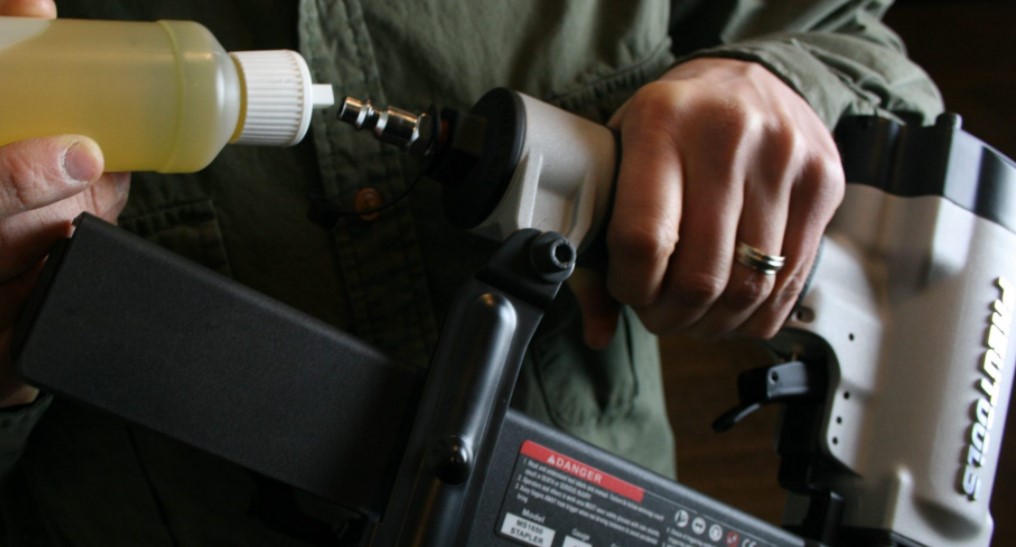 The main aim of these tools is to release oil slowly, helping ensure that you add the right amount of oil to your tool. Adding too much or too little could damage your tools.
The main aim of these tools is to release oil slowly, helping ensure that you add the right amount of oil to your tool. Adding too much or too little could damage your tools.
There are many methods for oiling air tools. The most common ones are outlined below.
This is the most common method of oiling nail guns, impact wrenches, air hammers, die grinders, etc.
If your tool doesn’t a specific oil reservoir, disconnect the compressed air pipe from the inlet of the power tool. Then you could complete the task by adding a few drops of oil to the air inlet. Once you connect the tool’s inlet to the air hose, the compressed air will distribute the oil from here.
Some tools have an oil reservoir. Use a screwdriver or hex wrench set to open the reservoir if yours is like this. Drip oil here until you reach the required volume as prescribed in the manual.
An air tool oiler is specially designed to add oil to pneumatic equipment.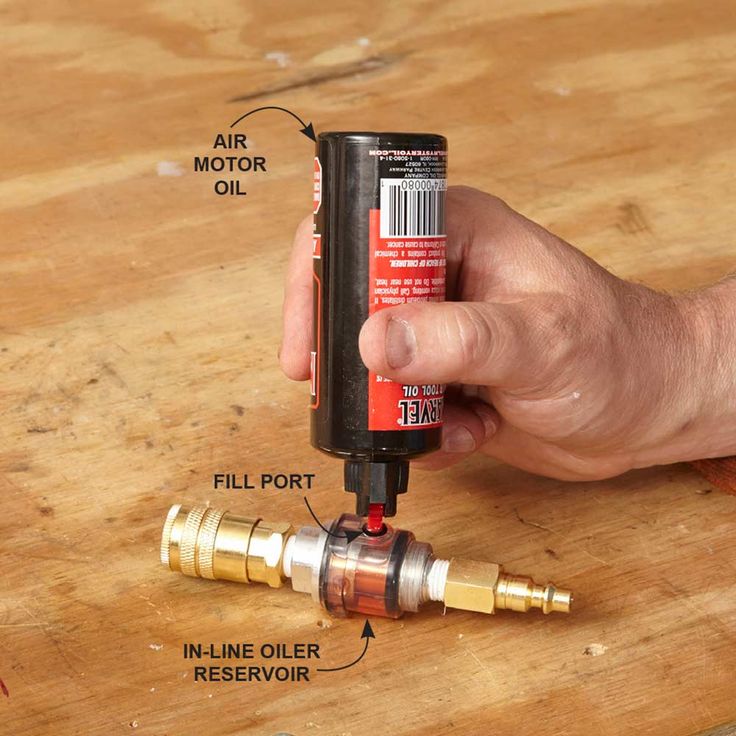 Fill the oiler with the correct amount of air tool oil to use this. Next, attach the oiler before the tool’s air inlet. The oil will be distributed through your tool as air passes through the tool oiler. Ensure that the air tool oiler is attached at the tool end of your air system, not at the compressor side. Typically, multiple tools will run off the same compressor system, which may have differing oil needs. Attaching the pneumatic tool oiler to the compressor side will distribute the oil to all equipment and thus potentially damage tools that aren’t compatible with that oil.
Fill the oiler with the correct amount of air tool oil to use this. Next, attach the oiler before the tool’s air inlet. The oil will be distributed through your tool as air passes through the tool oiler. Ensure that the air tool oiler is attached at the tool end of your air system, not at the compressor side. Typically, multiple tools will run off the same compressor system, which may have differing oil needs. Attaching the pneumatic tool oiler to the compressor side will distribute the oil to all equipment and thus potentially damage tools that aren’t compatible with that oil.
A lubricator is attached to the air system, similar to an air tool oiler. This tool releases oil into the air system at a controlled rate, ensuring that the tools are appropriately lubricated while in operation. Adjusting the drip rate (oil-fog or micro-fog) alters the rate at which the oil mist is released into the system – this rate depends on the application.
FRL is short for Filter, Regulator, Lubricator.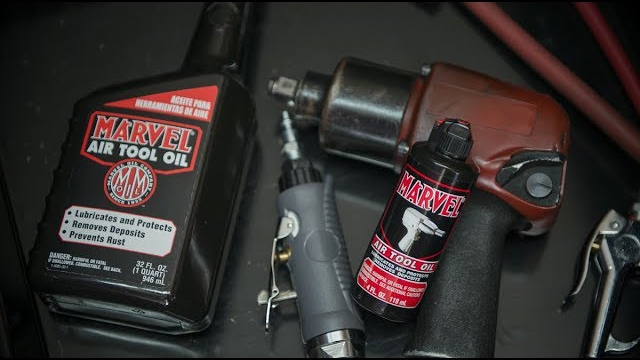 This unit supplies lubrication to the air tool. It also contains an air filter and regulator. The air filter prevents dirt from entering the power tool’s system. At the same time, the regulator maintains pressure on your tool according to manufacturer guidelines. Attaching this unit is a slightly larger task, but it precisely manages the oil supply to your air tool.
This unit supplies lubrication to the air tool. It also contains an air filter and regulator. The air filter prevents dirt from entering the power tool’s system. At the same time, the regulator maintains pressure on your tool according to manufacturer guidelines. Attaching this unit is a slightly larger task, but it precisely manages the oil supply to your air tool.
All air tools don’t use oil. There determining factor here is the driving mechanism. Generally, if the tool is driven by air, it needs air tool oil. If it’s only controlled by pneumatics, but not driven by compressed air, it doesn’t need to be oiled. There are exceptions to this rule, however.
Some pneumatic tools are made to be oil-less. These include oil-free nail guns for wood finishing, pneumatic screwdrivers used in clean-room conditions, etc. where you cannot have any oil on the final product. Check the user manual if you’re unsure whether your air tool needs oil.
Contents
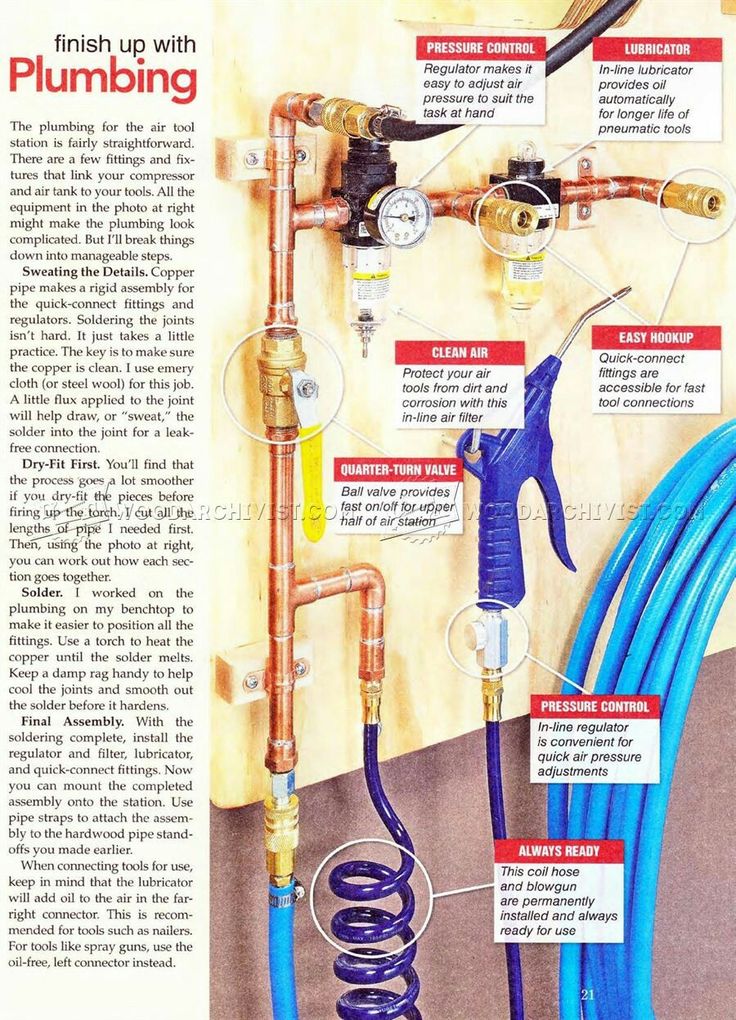 Automatic Transmission Fluid (ATF)
Automatic Transmission Fluid (ATF)Home » Air Tools
Often, pneumatic equipment is used during repair work, painting, anti-corrosion treatment.
Pneumatic tools include various types of screwdrivers, grinders, pneumatic drills, chisels, riveting hammers and other items designed to increase labor productivity with the least expenditure of physical strength.
To work effectively, a pneumatic tool needs care and, most importantly, high-quality lubrication. Due to a number of advantages, pneumatic tools compete with power tools.
The main features of the pneumatic tool include its safety, low noise and vibration levels. It is simple and unpretentious in operation, it works in a wide range of temperatures, in various conditions.
The main advantage is the high power of pneumatic motors with a small size and weight.
In other words, pneumatic tools provide high labor productivity with low staff fatigue.
However, for long-term and productive operation of pneumatic tools, it is necessary to comply with the technical requirements, which indicate the lubrication regime and recommended lubricants.
It is best to regularly, before each work shift, bury 2-5 drops of special oil in the inlet fitting of the tool.
This is the easiest way to keep your air tool in good condition.
However, there is another way - to install a mini-lubricator or an air preparation unit on the device. For pneumatic tools, it is recommended to use a special oil with special additives, because. any other industrial oils adversely affect the rubber parts of the tool.
In addition to oil sprayers, there are other systems for lubricating with compressed air oil mist. The oil mist thus obtained has a high degree of homogeneity with a particle size of 0.3-2 µm. This greatly reduces oil consumption and also supplies lubricated air to devices up to 500 m away.
Mobil Almo is a paraffin-based mineral oil with emulsifiers, anti-wear, adhesion and anti-corrosion additives. The product is designed to protect against aging and corrosion in rotary hammers and other pneumatic tools.
Mobil Almo air tool oil meets all tests and specifications designed for oils used in heavy duty mining applications. It is approved by Ingersoll Rand Company, Joy Manufacturing Company and other companies.
It is approved by Ingersoll Rand Company, Joy Manufacturing Company and other companies.
Was the article helpful?
(ratings)
A wide variety of different types of pneumatic equipment allows you to perform a wide range of different kinds of work both in large industries, in small auto repair shops, in various factories, and in domestic conditions. Depending on the type of pneumatic tool, its performance and technical indicators, you can choose equipment for small jobs around the house - from minor repairs to garden work, as well as for use in large industry.
For efficient performance of work, it is necessary to choose the right equipment. In addition, the connection and use of pneumatic tools must be performed correctly and taking into account the specifics of the work ahead. The pneumatic tool works from the compressor system and therefore, first of all, it is necessary to choose the right compressor with the desired characteristics - the final pressure indicator, the performance level, and others.
So, after we have taken the right compressor suitable for working with the selected pneumatic equipment, it is necessary to connect the pneumatic tool correctly. Compliance with all rules and requirements both for connecting equipment to a compressor unit and for working with a tool will allow not only competently and efficiently perform all the necessary work, but also eliminate the possibility of tool breakage and make the use of the entire pneumatic system as safe as possible.
Here you can find the catalog of pneumatic tools sold by TechMash Group LLC.
The first stage is preparation for work, which consists in the competent organization of the air supply system to the pneumatic equipment under pressure. This system, in addition to the compressor itself, consists of both basic elements, which include flexible hoses, and additional ones - lubricators, various filters, as well as oil and moisture separators.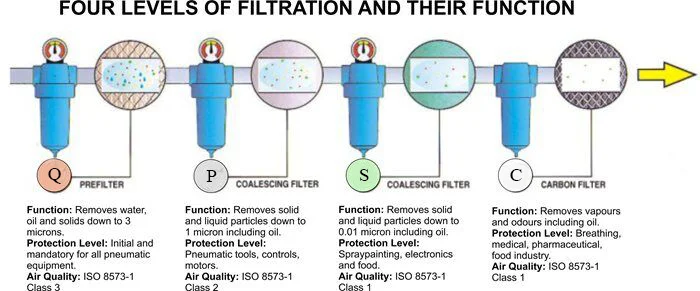 The air supplied by the compressor contains various impurities - dust, abrasive particles, water, and also oil in the case of using an oil compressor. The ingress of dust and other particles into the pneumatic mechanism can lead to premature equipment failure, and the presence of moisture, which is the result of condensate or oil, can adversely affect the quality of work performed. That is why it is necessary to prevent these impurities from entering the pneumatic system.
The air supplied by the compressor contains various impurities - dust, abrasive particles, water, and also oil in the case of using an oil compressor. The ingress of dust and other particles into the pneumatic mechanism can lead to premature equipment failure, and the presence of moisture, which is the result of condensate or oil, can adversely affect the quality of work performed. That is why it is necessary to prevent these impurities from entering the pneumatic system.
A moisture separator is used to remove oil or moisture from compressed air, which is especially necessary for long and intensive work. If the pneumatic equipment is used in domestic conditions and for a short time, it is enough to drain the condensate from the receiver before starting work. Air purification from dust and other particles is carried out by filters that can be either built into the compressor or installed additionally to more effectively eliminate impurities. At the same time, it is necessary to periodically clean the filters or replace them, which will prevent the failure of the filtration system and the ingress of polluted air into the pneumatic system.
During the operation of the pneumatic tool, it is required to provide it with a special lubricant that prevents friction of the working elements and their premature breakage. To do this, a lubricator is installed to ensure a regular supply of lubricant to the pneumatic system. The presence of a lubricator and an oil separator, as well as their correct installation, helps prevent breakage of the working parts of pneumatic equipment, while obtaining purified compressed air.
Pneumatic equipment is directly connected to the compressor using special hoses - in the case of using the equipment in domestic conditions. If the work is carried out in any production, first of all, a plastic or metal pipeline is installed, to which pneumatic equipment is then connected using splitters.
Special nipples, fittings and adapters are used to connect flexible hoses, through which compressed air flows from the source to pneumatic equipment, with a compressor, pneumatic tools and other parts of the pneumatic route, which allow you to perform the fastening with the highest quality.
When connecting and using pneumatic tools, it is necessary to comply with some safety requirements: make work as safe as possible;
The use of pneumatic tools provides many advantages, including convenience and ease of use, the ability to work in almost any environment, a wide range of jobs and much more. In addition, the correct connection and use of pneumatic tools allows you to perform the necessary work as efficiently and quickly as possible.